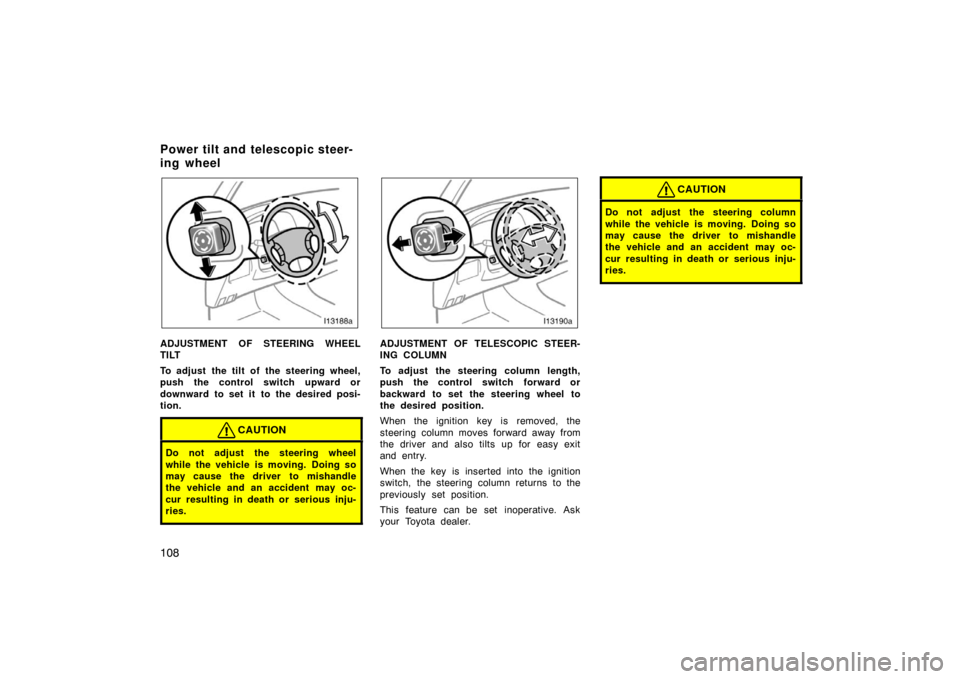Page 122 of 374

108
ADJUSTMENT OF STEERING WHEEL
TILT
To adjust the tilt of the steering wheel,
push the control switch upward or
downward to set it to the desired posi-
tion.
CAUTION
Do not adjust the steering wheel
while the vehicle is moving. Doing so
may cause the driver to mishandle
the vehicle and an accident may oc-
cur resulting in death or serious inju-
ries.
ADJUSTMENT OF TELESCOPIC STEER-
ING COLUMN
To adjust the steering column length,
push the control switch forward or
backward to set the steering wheel to
the desired position.
When the ignition key is removed, the
steering column moves forward away from
the driver and also tilts up for easy exit
and entry.
When the key is inserted into the ignition
switch, the steering column returns to the
previously set position.
This feature can be set inoperative. Ask
your Toyota dealer.
CAUTION
Do not adjust the steering column
while the vehicle is moving. Doing so
may cause the driver to mishandle
the vehicle and an accident may oc-
cur resulting in death or serious inju-
ries.
Power tilt and telescopic steer-
ing wheel
Page 183 of 374

169
(b) Automatic leveling function
Regardless of the number of occupants
or the luggage loading condition, the
vehicle height is always automatically
adjusted to a fixed height in any mode.
However, the vehicle height cannot be
raised if the vehicle load exceeds the lim-
its. (See “(d) Vehicle height adjustment”
described below.)(c) Vehicle height mode changing
condition
To change the vehicle height, it is nec-
essary to meet the following 3 condi-
tions.
�The engine should be running.
�All the side doors and back door
should be closed.
�The height control “OFF” indicator
light should go off.
When selecting a mode with the four −
wheel drive control lever at “H”, there is
a vehicle speed limit. Refer to the follow-
ing table.
Yes = The mode can be selected.
No = The mode cannot be selected.
Low
modeNormal
mode
High
mode
At vehicle
stoppageYe sYe sYe s
Under about 30
km/h (19 mph)NoYe sYe s
About 30 km/h
(19 mph) or overNoYe sNo
In the following cases the active height
control suspension does not operate
even if the above conditions are all
met.
�The brake pedal has been depressed
for longer than about 5 seconds with
the vehicle stopped.
�The suspension fluid temperature is
lower than –30 �C (–22 �F). If the en-
gine is warmed up, the suspension
fluid temperature will be raised as the
inside of the engine compartment be-
comes warmer. Then the active height
control system becomes operable.
�Driving on the bumpy roads, which
may cause the suspension to fully
elongate.
�The steering wheel is operated abruptly
more than 3/4 turns with center differ-
ential lock system activated.
Page 367 of 374
353
BRAKES
Minimum pedal clearance when depressed
with the force of 490 N (50 kgf, 110 lbf)
with the engine running, mm (in.): 116 (4.6)
Pedal free play, mm (in.): 1 – 6 (0.04 – 0.24)
Pad wear limit, mm (in.): 1.0 (0.04)
Lining wear limit, mm (in.): 1.0 (0.04)
Parking brake adjustment when pulled with
the force of 196 N (20 kgf, 44 lbf): 4 – 6 clicks
Fluid type: SAE J1703 or FMVSS No.116 DOT 3
STEERING
Wheel free play: Less than 40 mm (1.6 in.)
Power steering fluid type: Automatic transmission fluid DEXRON
II
or III
SUSPENSION
Fluid type: Suspension fluid AHC